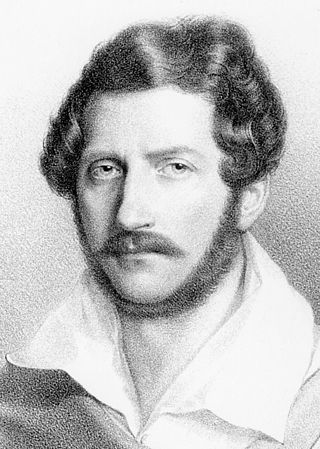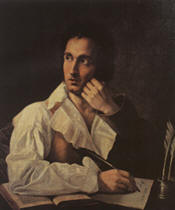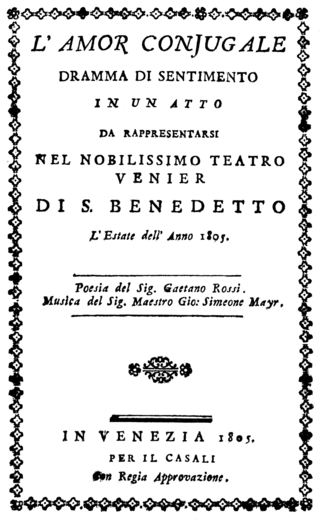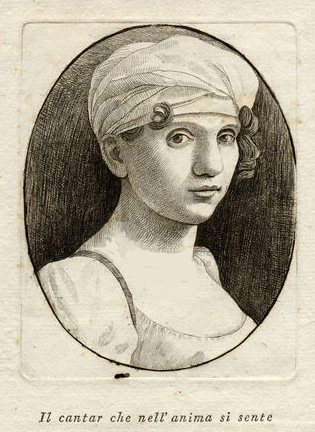Related Research Articles

Giuseppe Felice Romani was an Italian poet and scholar of literature and mythology who wrote many librettos for the opera composers Donizetti and Bellini. Romani was considered the finest Italian librettist between Metastasio and Boito.

Johann(es) Simon Mayr, also known in Italian as Giovanni Simone Mayr or Simone Mayr, was a German composer. His music reflects the transition from the Classical to the Romantic musical era. He was an early inspiration to Rossini and taught and advocated for Donizetti.

Il diluvio universale is an azione tragico-sacra, or opera, by Gaetano Donizetti. The Italian libretto was written by Domenico Gilardoni after Lord Byron's Heaven and Earth and Francesco Ringhieri's tragedy Il diluvio (1788).

Alfredo il grande is a melodramma serio or serious opera in two acts by Gaetano Donizetti. Andrea Leone Tottola wrote the Italian libretto, which may have been derived from Johann Simon Mayr's 1818 opera of the same name. The opera tells the story of the Anglo-Saxon king Alfred the Great.

Jacopo Ferretti was an Italian writer, poet and opera librettist. His name is sometimes written as Giacomo Ferretti.
Attalia is the ancient name of Antalya, a city on the Mediterranean coast of southwestern Turkey.

L'amor coniugale is an opera in one act by Simon Mayr set to an Italian libretto by Gaetano Rossi. It premiered at Padua's Teatro Nuovo on 26 July 1805.

Elisabetta Manfredini-Guarmani was an Italian opera singer best known for having created the leading soprano roles in four of Rossini's operas, roles which he wrote specifically for her voice. She was born Antonia Elisabetta Manfredini in Bologna and was the daughter of the composer and music theorist Vincenzo Manfredini. After her stage debut in 1810 when she sang in the premiere of Stefano Pavesi's Il trionfo di Gedeone at Bologna's Teatro del Corso, she went on to perform at La Fenice, La Scala, Teatro Regio di Torino, Rome's Teatro Argentina and several other opera houses, primarily in Northern Italy. In addition to the roles she created in Rossini's operas, she also sang in the world premieres of operas by several composers who are lesser known today, including Pietro Raimondi, Simon Mayr, and Ferdinando Paër. Her last known appearance was in 1828 after which there is no further trace of her. The date and place of her death are unknown.
Francesco Tortoli was an Italian scenographer, active in Naples from 1808 at the city's principal theatres—Teatro San Carlo, Teatro del Fondo and Teatro dei Fiorentini. He was the creator of sets for numerous productions including those for the world premieres of Rossini's La gazzetta, Otello, Armida, Mosè in Egitto, and La donna del lago. Tortoli was born in Florence and died in Naples of cholera at the age of 35.
Tobiae matrimonium, actio sacra pro filiabus chori S. Lazari is a 1794 oratorio by Simon Mayr to a Latin libretto by Giuseppe Maria Foppa. It was the third of Mayr's works written for the Ospedale dei Mendicanti. No exact date or circumstances for the original performance are known.
David in spelunca Engaddi is a 1795 oratorio by Simon Mayr. The librettist is unknown, but is possibly Giuseppe Maria Foppa who supplied the Latin texts for Iacob a Labano fugiens (1791), Sisara (1793), and Tobiae matrimonium (1794).
Iacob a Labano fugiens is a 1791 oratorio by Simon Mayr to a libretto by Giuseppe Maria Foppa for the Conservatorio dei Mendicanti, Venice.
Sisara is a 1793 Latin oratorio by Simon Mayr to a libretto by Giuseppe Foppa who also supplied the Latin texts for Iacob a Labano fugiens (1791) and Tobiae matrimonium (1794).
La passione di Gesù Cristo, is a 1794 Italian-language oratorio for soloists, choir and orchestra by Simon Mayr, to an adapted version of the famous libretto La passione di Gesù Cristo by Metastasio. Unlike Mayr's four Latin-language oratorios to librettos by Giuseppe Foppa for the Conservatorio dei Mendicanti, La passione was written for a church, and not limited to girls voices.
Samuele is an 1821 Italian-language oratorio by Simon Mayr to a libretto by Bartolomeo Merelli. It was performed on 2 June 1821 in Bergamo's Congregazione della Carità by pupils of the Lezioni caritatevoli to welcome the arrival of the new bishop Pietro Mola.
Il sagrifizio di Jefte is a 1795 oratorio by Simon Mayr to a libretto by Giuseppe Foppa performed in Forlì.
Giuseppe Maria Foppa was an Italian librettist. He wrote around 150 libretti, mainly for comic operas, as well as Latin oratorio texts and his memoirs.
Innalzamento al trono del giovane re Gioas is an oratorio by Simon Mayr premiered in Florence in 1823. The anonymous libretto is unrelated to the two dozen other oratorios of the name Gioas, all of them based on the 1735 libretto Gioas re di Giuda by Metastasio.

Talia Or is an Israeli-born operatic and concert soprano based in Germany. Her repertoire ranges from concert and lied to contemporary music. She is a lecturer on singing at Musikhochschule München.
References
- ↑ Helen M. Greenwald The Oxford Handbook of Opera 2014 p.733 0199714843 "To Mayr, Rossini's Mosè, Donizetti's Il diluvio universale, and his own Atalia all evidently count as “oratorios” because they are religiously sincere (Mayr 1843: 74r). When using the term “oratorio” in these cases, both Mayr and Rossini clearly ."